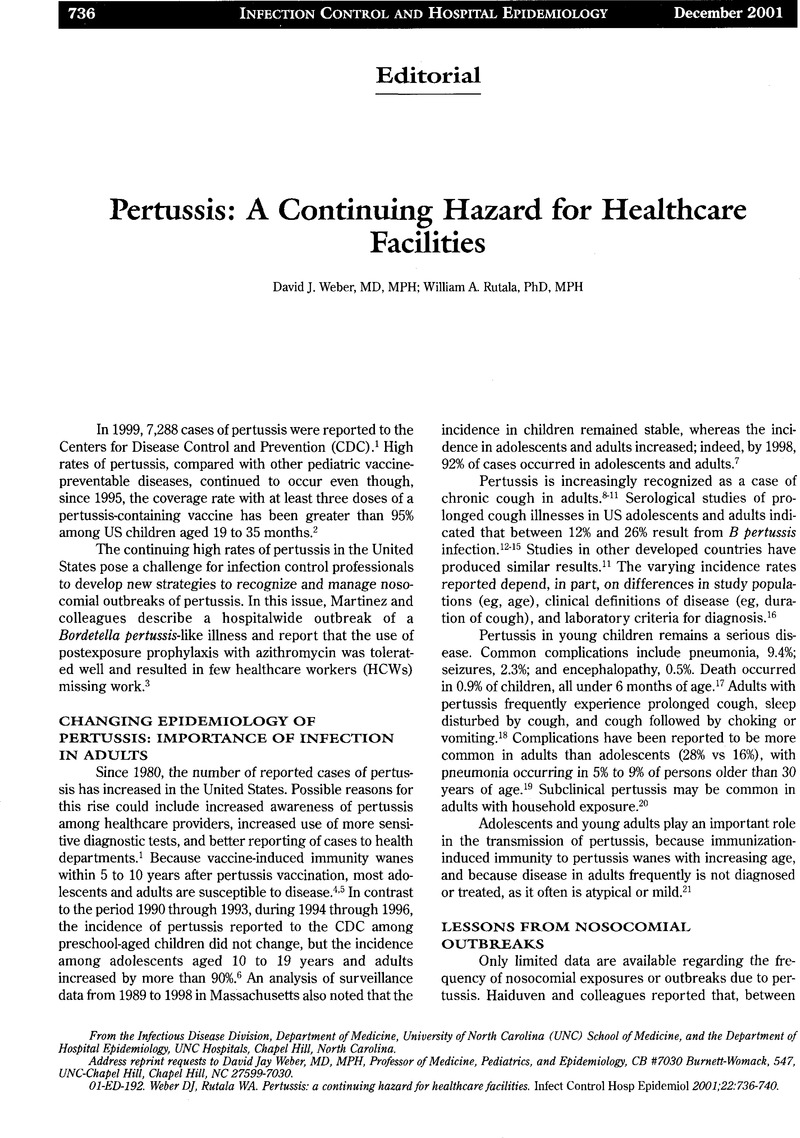Crossref Citations
This article has been cited by the following publications. This list is generated based on data provided by Crossref.
McCormack, Joseph G
Spearing, Natalie M
and
Horvath, Robert L
2003.
In reply: Pertussis: adults as a source in healthcare settings.
Medical Journal of Australia,
Vol. 178,
Issue. 4,
p.
191.
Greenberg, David P.
2005.
Pertussis in Adolescents.
Pediatric Infectious Disease Journal,
Vol. 24,
Issue. 8,
p.
721.
Chatterjee, Archana
Plummer, Sharon
Heybrock, Brenda
Bardon, Tami
Eischen, Kay
Hall, Mel
and
Lazoritz, Steven
2007.
A modified “cover your cough” campaign prevents exposures of employees to pertussis at a children's hospital.
American Journal of Infection Control,
Vol. 35,
Issue. 7,
p.
489.
Peadon, Elizabeth
and
Cooper, Carolyn
2007.
Whooping cough: Are health‐care workers putting children at risk?.
Journal of Paediatrics and Child Health,
Vol. 43,
Issue. 5,
p.
398.
Weisberg, Susan Shoshana
2007.
Pertussis.
Disease-a-Month,
Vol. 53,
Issue. 10,
p.
488.
2007.
Empfehlung zur Prävention nosokomialer Infektionen bei neonatologischen Intensivpflegepatienten mit einem Geburtsgewicht unter 1500 g.
Bundesgesundheitsblatt - Gesundheitsforschung - Gesundheitsschutz,
Vol. 50,
Issue. 10,
p.
1265.
Daskalaki, Irini
Hennessey, Patricia
Hubler, Robin
and
Long, Sarah S.
2007.
Resource Consumption in the Infection Control Management of Pertussis Exposure Among Healthcare Workers in Pediatrics.
Infection Control & Hospital Epidemiology,
Vol. 28,
Issue. 4,
p.
412.
Long, Sarah S.
and
Edwards, Kathryn M.
2008.
Principles and Practice of Pediatric Infectious Disease.
p.
858.
Weber, David J.
and
Rutala, William A.
2008.
Vaccines.
p.
1453.
Greer, Amy L.
and
Fisman, David N.
2009.
Keeping Vulnerable Children Safe from Pertussis Preventing Nosocomial Pertussis Transmission in the Neonatal Intensive Care Unit.
Infection Control & Hospital Epidemiology,
Vol. 30,
Issue. 11,
p.
1084.
Greer, Amy L.
and
Fisman, David N.
2011.
Use of Models to Identify Cost-effective Interventions: Pertussis Vaccination for Pediatric Health Care Workers.
Pediatrics,
Vol. 128,
Issue. 3,
p.
e591.
Zastrow, Rachel L.
2011.
Emerging Infections: Pertussis on the Rise.
AJN, American Journal of Nursing,
Vol. 111,
Issue. 6,
p.
51.
Kusek, Linda
2011.
Tdap Vaccination Strategies for Health Care Personnel.
Journal of Nursing Care Quality,
Vol. 26,
Issue. 4,
p.
287.
Long, Sarah S.
Edwards, Kathryn M.
and
Mertsola, Jussi
2012.
Principles and Practice of Pediatric Infectious Diseases.
p.
865.
Weber, David J.
and
Rutala, William A.
2013.
Vaccines.
p.
1290.
Calderón, Tirza A.
Coffin, Susan E.
and
Sammons, Julia S.
2015.
Preventing the Spread of Pertussis in Pediatric Healthcare Settings.
Journal of the Pediatric Infectious Diseases Society,
Vol. 4,
Issue. 3,
p.
252.
Weber, David J.
and
Rutala, William A.
2016.
Occupational Health Update.
Infectious Disease Clinics of North America,
Vol. 30,
Issue. 3,
p.
729.
Weber, David J.
and
Rutala, William A.
2018.
Plotkin's Vaccines.
p.
1402.
Long, Sarah S.
Edwards, Kathryn M.
and
Mertsola, Jussi
2018.
Principles and Practice of Pediatric Infectious Diseases.
p.
890.
Cimolai, Nevio
2021.
Pharmacotherapy for Bordetella pertussis infection. II. A synthesis of clinical sciences.
International Journal of Antimicrobial Agents,
Vol. 57,
Issue. 3,
p.
106257.



